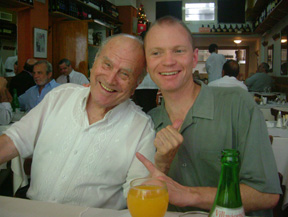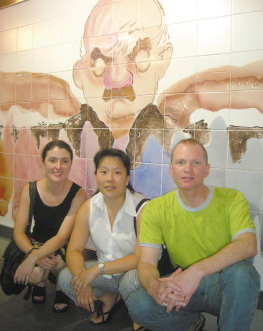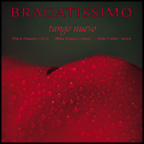"...performances that fully convey all the intense drama, melancholy and intimacy of pieces
by Piazzolla and others, most of it arranged for piano duo/trio by long-time Piazzolla musical
colleague, Jose Bragato. Hansen's playing here has an introspective quality that lacks none of
the passion, elegiac beauty of tone and understated virtuosity usually associated with the
artistry of a Yo Yo Ma."
- Bob Clark, Calgary Herald - FIVE STARS

Glowing with nuevo tango's crepuscular combination of passion and melancholy, the CD consists primarily of works composed or arranged by Bragato, including two debut recordings, and his originals complement the quartet of Piazzolla compositions that highlight this haunting album.
- Brett Campbell, Eugene Weekly
performers
Philip Hansen has performed to acclaim in a variety of musical settings. The Oregonian has noted his playing
as "dazzling" and "indefatigable," and the Los Angeles Times praised him for his "admirable virtuosity." Pulitzer
Prize-winning composer David del Tredici says "Phil Hansen brings virtuosity and élan to all that he plays."
A native of California, Mr. Hansen is currently principal cellist of the Calgary Philharmonic Orchestra. He has performed
as soloist with orchestras around the USA, including concerti by Dvorak, Haydn, Tchaikovsky, and Richard Strauss' Don Quixote.
Formerly principal cellist of the Knoxville Symphony Orchestra, Phil has also served as guest principal of the Nashville
Chamber Orchestra. He has played in the Colorado Symphony, Rochester Philharmonic, Oregon Symphony, the Ernest Bloch Festival,
and in the Oregon Festival of American Music, where he also appeared as guest conductor.
At the invitation of composer and MacArthur fellow Bright Sheng, Phil performed a recital of unaccompanied works and taught
master classes at the Shanghai Conservatory of Music. Formerly artistic director and cellist for the 21st Century ensemble
Fear No Music, he performed with that group in New York's Merkin Hall a work for cello and ensemble by American composer
Kenji Bunch.
Mr. Hansen's education includes cello, composition, and conducting studies at the Eastman School of Music and University
of Southern California. His teachers include Steven Doane, Lynn Harrell, Jurgen deLemos, Patricia Pinkston, Joseph DiTullio,
and Eleonore Schoenfeld. Phil was twice selected to participate in the prestigious Piatigorsky Seminar for Cellists, where
he received master class instruction from, among others, Yo-Yo Ma and William Pleeth. Phil performs on an English cello
made in 1780 by Lockey Hill.
Mika Sunago, a native of São Paulo, Brazil, has performed and placed in several national and international
competitions throughout Brazil, USA and Japan. Mika completed her degrees in Piano Performance and Conducting at Indiana
University. At Indiana University, Mika received lessons and participated in master classes by Menahem Pressler, Gyorgy
Sebok, Leonard Hokanson, and Michel Block to name a few.
Mika has played for renowned masters such as Josef Gingold, Franco Gulli and Janos Starker. During the years when Mika
lived in New York City, she was a collaborative pianist for performers such as Leila Josefowicz, Hannah Chang and Christine
Walewska. She was also an accompanist for many opera singers from the Metropolitan Opera House. Her performances and
interviews of Latin American music have been broadcast in radio and TV programs in the USA (NPR), Japan (NHK and ABC),
Austria (ORF), Argentina (Solo Tango and RAE) and Brazil (FM Cultura/TV Cultura). Mika has performed chamber music and
solo concerts throughout Brazil, Argentina, Japan, and USA, including Puerto Rico.
Mika now lives in Portland, Oregon. She frequently performs with Third Angle Ensemble, Fear No Music, the Oregon Symphony
and Tango Pacifico. In addition to engagements with several groups every year, Mika has collaborated in recordings of
many CDs and TV programs of contemporary musicians (Steve Reich, Lou Harrison). Mika has two CDs released: "Between the
Tropics" (collection of solo Latin American Piano Music) and "Café 1930" (Piazzolla Tangos) which were featured in
several music magazines and newspapers in Asia and South America. As a Brazilian living in the USA, Mika's has had a
special interest in introducing Latin classical music to American audiences.
Mika recently completed her Baccalaureate in Nursing at Good Samaritan - Linfield School of Nursing.
Erin Furbee joined the Oregon Symphony as Assistant Concertmaster in 2001. Prior to her arrival in Portland, she
was a member of the Colorado Symphony for eight years, and also played with the Milwaukee Symphony for a season.
Originally from Chicago, Erin attended the University of Michigan, received her B.M. from the Shepherd School of Music
(Rice University), and did her graduate work at the University of Minnesota. Her main teachers have been Camilla Wicks,
Raphael Fliegal, Jacob Krachmalnick, and Roland and Almita Vamos. She has performed as a soloist with the Oregon Symphony,
the Colorado Symphony, and the University of Minnesota Symphony Orchestras.
Besides her great love for classical music, Erin enjoys playing Tango music, a passion she developed after first hearing the
music of Astor Piazzolla in 1997. While living in Denver, she and fellow bandoneon player Evan Orman co-founded a four piece
tango group called Extasis and traveled to Buenos Aires in 1999 to study with musicians in many of the tango orchestras there.
In Portland, Erin feels very fortunate to be playing with two tango groups. In 2001, she formed Tango Pacifico, which has been
featured on the Chamber Music on Tap series and received a grant in 2002 from the Knight Foundation to perform a show of Tango
and Samba music at the PNCA .
She also plays with Conjunto Berretin, a 6-piece ensemble which often performs at milongas for dancers, and has been featured
at Portland Tangofest and Valentango. In June, 2004, Erin returned to Buenos Aires for a month where she studied and performed
with tango musicians, took Spanish lessons, and learned to dance--the ultimate tango experience! Erin is also an avid chamber
musician, and is currently a member of Fear No Music. She has also played with the Colorado Chamber Players, the Mariposa
Piano Trio, and the Modern Music Festival. She enjoys teaching privately as well as coaching for auditions. In her spare
time, she hikes, dances, and studies yoga and Spanish.
Special thanks to: Jack Gabel for infinite
professionalism and patience; Erin Furbee and Mika Sunago for their immense artistry and friendship; Sue Hansen; David Jimerson
and Valley Community Presbyterian Church; Tom Levings for piano tuning.

|
STREAMING AUDIO SAMPLES
If not installed, download free player (links below).
Then set browser preferences to player of choice.
|
|
No fat downloads
streams only
|



 mp3 (32kbps) audio
(streaming excerpts)
|
| [1] Graciela y Buenos Aires J. Bragato |
LISTEN |
| [2] Decarissimo* A. Piazzolla; arr: J. Bragato |
LISTEN |
| [3] Milonga A. Piazzolla |
LISTEN |
| [4] Le Petit Tango C. Tirão; arr: J. Bragato |
LISTEN
|
| [5] Bragatissimo* A. Piazzolla; arr: J. Bragato |
LISTEN |
| [6] Canto C. Guarnieri |
LISTEN |
| [7] Tango III W. Castro |
LISTEN |
| [8] Primavera Porteño A. Piazzolla; arr: J. Bragato |
LISTEN |
| [9] Milontan J. Bragato |
LISTEN |
| [10] Tango II W. Castro |
LISTEN |
| [11] Oblivion A. Piazzolla; arr: J. Bragato |
LISTEN |
| * indicates premiere recording release |
| |
BRAGATISSIMO
From humble beginnings tango swept the world in an extremely short period of time.
Originating in the streets and bordellos of mid-19th century Buenos Aires, its music
was influenced by Italian émigré performers who blended the musical
sounds of their home country with those of Spain, Uruguay, and Argentina. Later
infused by a German accordion-like instrument now known as the bandonón, tango
became the latest "world fusion" music to emerge. By 1913, sometimes called
"Year of the Tango," the music and dance had swept Paris, becoming ubiquitous
in other world capitals soon thereafter.
The "golden age of tango," from the mid-1930's through the mid-50's, saw tango musicians
unite to form bands, many of which became huge successes. Around the same time, the
dance came of age as well. Pieces written during that time were given a faster tempo
and thus became even more popular among dancers. The return of a young Astor Piazzolla
to Buenos Aires from Paris in 1955 gave an emerging new form, tango nuevo, a chance
to develop. Ironically his return to Argentina coincided with a coup against Péron
which resulted in the repression of tango, an art form considered too nationalistic by
the new regime. Although he had studied classical composition with Nadia Boulanger,
Piazzolla's tango nuevo reflected a new concert-oriented music, which was jazz-infused,
experimental in harmony and instrumentation, and less rhythmic than traditional tango.
Interesting to only the most dedicated concert-goers and professional dancers, it is no
surprise that tango nuevo became controversial among dancers and lovers of traditional
tango. In fact tango nuevo was seen by many as a threat to the very existence of tango.
Riots took place in the concert halls of Buenos Aires similar to the one facing Stravinsky
at the premiere of his Rite of Spring. Fortunately neither musical form ever neared extinction,
and in fact both forms would eventually thrive independently of each other. With the fall of
the military junta in 1983 and the introduction of tango shows worldwide, both tango and
tango nuevo grew exponentially in popularity and continue to thrive.
The close association of tango nuevo composers Astor Piazzolla and José Bragato
was characterized by their deep friendship and mutual respect. As the cellist in Piazzolla's
band, Bragato performed many works that featured the cello prominently, with Piazzolla
playing the bandonón. The two of them can be heard and seen in video and audio clips
made of Piazzolla's band performing as they toured the globe.
 Maestro José Bragato with Phil Hansen
Maestro José Bragato with Phil Hansen
In honor of his friend José Bragato, Piazzolla would eventually pen the work Bragatissimo.
As a tribute to José Bragato and to their close association, this CD bears the name of
that special work. Often associated with his arrangements of works by Piazzolla and other composers,
Bragato is in fact a great tango nuevo composer in his own right. Incendiary passion, melancholy,
and humor are characteristic of his remarkable collection of works. Bragato's tunes are infectious
and soul-baring, capturing a work's searing essence with succinct and lean technique.
Bragato and his family immigrated to Argentina from Italy while he was as a teenager. A staunch
defender of democratic ideals, Maestro Bragato spent several years in Paraguay as a political
exile following the Perón era. Though he resides again in his home country, Bragato remains a
treasure to Paraguayans as well as to his own countrymen.
It was a joyful and surprising adventure to compile works for this CD. Wine from the Mendoza
region of Argentina accented our visits with Maestro Bragato at his home in Buenos Aires, visits
which were full of anecdotes about his many adventures in the world of music. During our time with
the maestro, bit by bit he shared with us what turned out to be a gold mine of original compositions,
as well as his arrangements of music by Piazzolla, among others. His generosity and humility in
revealing his work to us were remarkable.
In compiling potential works for this recording, we considered many South American composers, and
distilled again and again the playlist. As our selections narrowed, we found we were left mostly
with works and arrangements by Maestro Bragato. His pieces and arrangements show a passionate,
joyous, and poetic man. With deep gratitude, we dedicate this CD to Maestro José Bragato.
program notes
At the time this piece was written,"Graciela" of Graciela y Buenos Aires was a young cellist
and the wife of a leading musician in a Swiss orchestra. Despite the inference of the piece's title
and whatever influence she may have had on this work, Graciela never actually made it to Buenos Aires.
Decarissimo is a tribute by Piazzolla to tango composer Julio De Caro. Also a violinist,
De Caro popularized the odd-sounding and looking violin/cornet combination put out by Victor in
the early 20th century. His music was championed by fellow composer Osvaldo Pugliese and reflected
a new lyrical style of violin playing in tango.
Milonga refers to a fast-paced dance, but its name also means a gathering for tango dancing.
One can imagine that Piazzolla intended his haunting work of the same name to be a reflection on
love-lorn dancers expressing themselves through tango.
Guitarist and composer Cacho Tirão was a long-time friend of both Piazzolla and Bragato, who
arranged Le Petit Tango for cello and piano based on the original for cello and guitar.
Tirão was also a guitarist in Piazzolla's band.
Bragatissimo (see above) by Piazzolla is arranged here for piano trio by the dedicatee, his
devoted friend, Maestro José Bragato.
The only non-Argentinian work in this collection, Canto was originally composed for violin
and piano. The composer's coupling of intimate melodies and traditional Brazilian rhythms resulted
in a sophisticated style that still possesses immediate appeal. Its dotted rhythms evoke the tango.
It was written, perhaps not coincidentally, during tango's "golden age" of the mid-20th century.
Washington Castro's Tangos are replete with dramatic gesture and quirky twists, revealing the
musical language of a rebel. Like José Bragato, the composer was a cellist. After studies
with Pablo Casals, he performed around Europe and Argentina, and later became a conductor. A longtime
resident of Mar del Plata, Argentina, he was a good friend of Bragato, who still has a summer home
there. Castro's music remains mostly unpublished.
Primavera of Primavera Porteño means "springtime"- and porteño is the slang word
for a resident of the port area of Buenos Aires, which is often associated with early tango. A movement
from Piazzolla's Four Seasons, this piece comprises a devilish fugue as arranged for piano trio by Maestro
Bragato.
The pleading, lyrical Milontan is dedicated to American cellist Christine Waleska, who resided at
one time in Buenos Aires and was featured on some well-known recordings of the 1970's. The title is
derived from the words milonga and tango.
Astor Piazzolla's Oblivion, one of his best-known works, is presented here in a recent arrangement
for piano trio by Maestro Bragato. Also known as J'oublie (I Forget), it is found on many recordings and
in a wide variety of instrumentations.
notes by Philip Hansen








